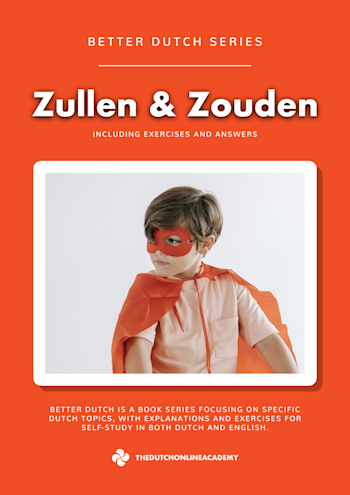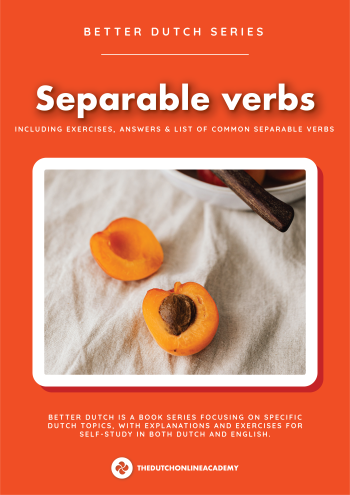Learn the theory
Three main scenarios for word order in Dutch
In this article we are going to focus on the three scenarios for word order. You will learn these scenarios already during an A2 course, but the difference between them will keep you busy all the way to fluency!
Be aware that questions, imperative and the (om) + te construction are not taken into account in this explanation.
Do you really want to know everything about Dutch word order? Take a look at our Video Course.
Scenario 1: a regular sentence (a main clause or "hoofdzin")
This is the easiest one. Just start with a subject followed by the conjugated verb.
- Ik ben Richard.
- Hij woont in het centrum.
- Petra en Hannah werken allebei in het ziekenhuis.
Do you have more than one verb? No problem. Just put the conjugated one on the second place and the rest in infinitive form at the end. Often it's just one verb, but there could be many!
- Ik wil het museum bezoeken.
- Mijn buren proberen een nieuw huis te kopen.
- Wij zouden haar vandaag moeten helpen.
- Matthijs heeft gisteren de hele dag zitten werken. ( this is perfectum with double infinitive)
You can combine two regular sentences by maar, en, of, want & dus ( M.E.O.W.D.). In both sentences the conjugated verb is on the second place.
- Ik wil het museum bezoeken, maar het regent vandaag.
- Mijn buren proberen een nieuw huis te kopen, want ze willen graag een tuin hebben.
- Petra en Hannah werken allebei in het ziekenhuis en ik werk bij de bank.
Using M.E.O.W.D. is a very secure easy way to form long sentences. Handy during the Dutch inburgeringsexam!
Scenario 2: a regular sentence with inversion
This one you probably know already! When you start a sentence with an adverb instead of a subject, you get inversion. The word inversion makes it sounds like you have to do something strange, but all you have to remember is: keep that conjugated verb in the second place in the sentence! This means the subject follows right behind it (unlike in English).
- Gisteren was het lekker weer.
- Vanavond ga ik spaghetti eten.
- Af en toe werken zij in het ziekenhuis.
Inversion is optional. You can always start with the subject and avoid inversion if you like, although it's very common to use it in day to day speech.
Inversion can also follow after M.E.O.W.D.
- Ik wil het museum bezoeken, maar vandaag regent het.
Scenario 3: the subordinate clause (de bijzin)
Here it gets a bit more difficult. The subordinate clause feels very unnatural for many Dutch learners, but it is extremely important to practice, because the subordinate clause pops up everywhere.
A subordinate clause makes all verbs go to the end of the sentence. But don't forget to conjugate!
There are a few reasons to use the subordinate clause.
1. Subordinate clause: Dutch conjunctions that are not MEOWD
In the sentences below, the conjunctions that are not M.E.O.W.D. are in bold. The conjugated verb is underlined. These conjunctions trigger a subordinate clause to follow.
- Hij is blij, omdat de zon schijnt.
- Bel me, als je morgen wil afspreken.
- Ik ga naar huis, zodra het donker wordt.
- Wij woonden bij onze ouders, toen we jong waren.
- Regelmatig bestel ik een pizza, hoewel ik heel goed kan koken.
2. Subordinate clause: indirecte speech
This explanation will be a short version of the explanation of indirect speech here.
Indirect speech is used all the time, because it's counterpart - direct speech - is more or less only used in film scripts.
- Direct speech Piet zegt: "ik kan heel goed zwemmen."
- Indirect speech: Piet zegt dat hij heel goed kan zwemmen.
As you can see, there is a subordinate clause in the sentence with indirect speech. Indirect speech can be used with dat as a connector or of or a question word (hoe, wie, wat, etc.)
3. Subordinate clause: relative clause
This explanation will be a short version of the explanation of the relative clause here.
You use a relative clause to say something about a noun. You give more information about the noun.
- Ik heb een hond die altijd heel hard wil rennen.
- Heb je het schilderij gezien dat al driehonderd jaar oud is?
The relative clause can have dat as a connector or die depending on whether it is a de or het-woord. If you have a preposition in the relative clause, you should use waar + prepositie or prepositie + wie. Read more here.
Something to keep in mind while making long Dutch sentences
This was Dutch word order in a nutshell! Remember the basic rules:
- There is always a conjugated verb, also in the subordinate clause.
- Other verbs are in full form (infinitive).
- There is always a subject (except in the imperative).
- The subject and the conjugated verb have to match.
Do you want to have a good and clear explanation about conjunctions + exercises and answers to practice by yourself? Take a look at the PDF!
Some ideas to keep learning
Did you like this article? Why not dive deeper with our video course about word order?
comments
Login to leave a comment



![Learn Dutch with The double infinitive in Dutch [list of auxiliary verbs included]](https://images.ctfassets.net/f8l4gy5qxe00/7fpaN2iBE3h1xS7LRL8c0h/3bbebedc080cbf7eece73424c8e3918f/The_double_infinitive.png?w=350&h=495&q=50&fm=png)